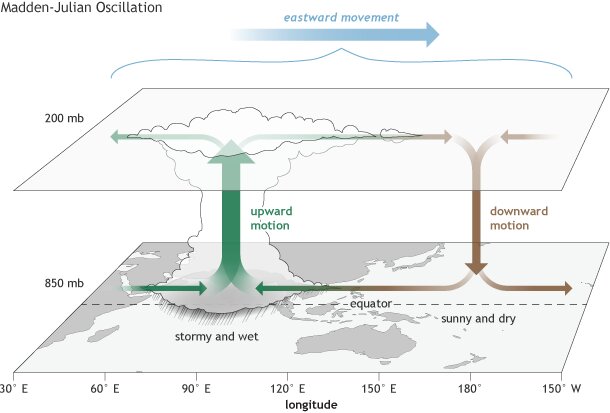Madden-Julian Oscillation (MJO) | 21 May 2019
According to India Met Department (IMD), the Arabian Sea arm of south-west monsoon is counting on an itinerant Madden-Julian Oscillation (MJO) wave for normal monsoon.
- It is an oceanic-atmospheric phenomenon which affects weather activities across the globe. It brings major fluctuation in tropical weather on weekly to monthly timescales.
- The MJO can be defined as an eastward moving 'pulse' of clouds, rainfall, winds and pressure near the equator that typically recurs every 30 to 60 days.
- It’s a traversing phenomenon and is most prominent over the Indian and Pacific Oceans.
Phases of Madden-Julian Oscillation
- The MJO consists of two parts or phases. Strong MJO activity often dissects the planet into halves. One half within the enhanced convective phase and the other half in the suppressed convective phase.
- Enhanced rainfall (or convective) phase: winds at the surface converge, and the air is pushed up throughout the atmosphere. At the top of the atmosphere, the winds reverse (i.e., diverge). Such rising air motion in the atmosphere tends to increase condensation and rainfall.
- Suppressed rainfall phase: winds converge at the top of the atmosphere, forcing air to sink and, later, to diverge at the surface. As air sinks from high altitudes, it warms and dries, which suppresses rainfall.
- It is this entire dipole structure, that moves west to east with time in the Tropics, causing more cloudiness, rainfall, and even storminess in the enhanced convective phase, and more sunshine and dryness in the suppressed convective phase.
How Does MJO Affect Indian Monsoon?
- The Indian Ocean Dipole (IOD), El Nino and MJO are all oceanic and atmospheric phenomena, which affect weather on a large scale. IOD only pertains to the Indian Ocean, but the other two affect weather on a global scale-up to the mid-latitudes.
- IOD and El Nino remain over their respective positions, while MJO is a traversing phenomenon.
- The journey of MJO goes through eight phases.
- When it is over the Indian Ocean during the Monsoon season, it brings good rainfall over the Indian subcontinent.
- On the other hand, when it witnesses a longer cycle and stays over the Pacific Ocean, MJO brings bad news for the Indian Monsoon.
- It is linked with enhanced and suppressed rainfall activity in the tropics and is very important for the Indian monsoonal rainfall.
- Periodicity of MJO:
- If it is nearly 30 days then it brings good rainfall during the Monsoon season.
- If it is above 40 days then MJO doesn't give good showers and could even lead to a dry Monsoon.
- Shorter the cycle of MJO, better the Indian Monsoon. Simply because it then visits the Indian Ocean more often during the four-month-long period.
- Presence of MJO over the Pacific Ocean along with an El Nino is detrimental for Monsoon rains.
